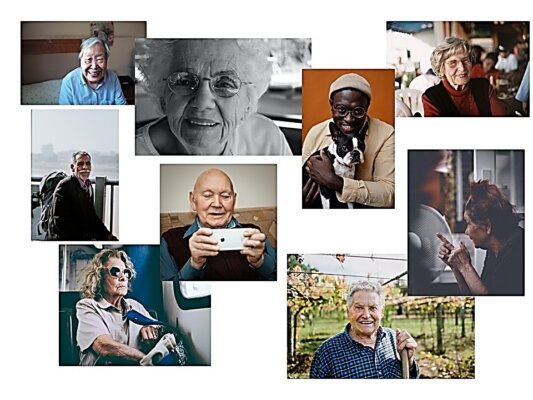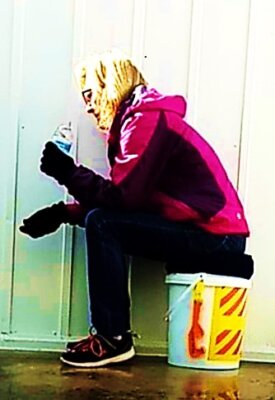Preparedness for Older Adults

I expect you are in much the same boat as I am. That is, as older adults, when it comes to preparedness much of what we learn about is theoretical or purely academic. Even with lifetimes behind us, few of us have ever personally had to give someone CPR, or run from a tsunami, or forage in the woods for food.
Over the past three weeks, though, we’ve been witnessing a situation in Ukraine that, while unfamiliar to most of us here, has entered our consciousness with exceptionally strong and vivid emotion.
As a senior citizen, I find my eyes drawn to the older people in all the pictures.
Unsteady on their feet, needing a hand to keep upright on a slippery bridge. Lying against a wall, exhausted. Struggling to carry their one bag of possessions while holding on to a hand or arm or a railing.
I can’t help but think about what would happen to my neighbors here in our community if we were forced to endure such conditions. And, naturally, my thoughts and observations lead into an Advisory.
What can older adults do to be better prepared for emergencies?
First, we can try to be in better physical shape!
Being isolated at home during Covid hasn’t helped. But many of my neighbors have pretty much stopped working or even walking – unless they have pets!
I am lucky to serve as an elementary school crossing guard. I get in at least two solid hours of standing and walking every day! At the same time, I know my balance isn’t as good as it once was. And at home I certainly have trouble getting up off the floor.
Do these limitations fit anyone YOU know?
Muscle is important. In the 2017 fires in Santa Rosa, CA, seniors died because they didn’t have the strength to open their garage doors when the electricity failed! And we’ve seen images of people on their roofs in Texas, escaping from flooding. Could you climb up to your roof?
I have discovered what I think is an excellent series of exercise videos for seniors. Prepare to meet Bob and Brad! They are somewhat goofy but their advice works! Here’s their 13 minute video from YouTube:
Second, we can think through what it would take for us to walk any real distance or wait in line for hours.
Obviously, if you have difficulty walking, part of preparing for emergencies is to have already made plans for assistance. For everyone, here are some aids to consider.
I would need a pair of really sturdy shoes. (I already know this because of my crossing guard duties.) Every one of my emergency kits – my Go-Bag and my car emergency kits – has shoes and socks among the very first items to be packed.

What about a way to rest, without having to sit or lie on cold or wet ground? This week our neighborhood group is looking at the value of using ordinary 5-gallon buckets as containers for emergency supplies. With the addition of a simple cushion, a bucket can become a seat, giving you a chance to take a rest, manage a drink of water — without having to struggle to your feet when the rest is over. (Foldable golf stools are great, too, though awkward if you’re boarding a vehicle.)
A back-pack allows you to carry your stuff and have both hands free, to reach for help or to offer it. A rolling cart may tie up one hand and arm, but you wouldn’t have to actually carry anything. As for a suitcase? Most seniors can’t carry one!
Third, we must rethink. What is the absolute minimum we want to carry with us in an emergency evacuation?
This is the most difficult list to come up with because each of us is so very different.
Here are some general ideas to consider.
- Prescription medicines – as much as you can carry. In turbulent times you’ll have no way to get a refill. (We’ve talked before about pressuring your doctor for extra pills.)
- Extra eyeglasses and/or hearing aids. Your safety and certainly your comfort depend on these aids. Again, in an evacuation setting there will be no way to get replacements.
- Phone and power bank. Who knows where you’ll find a free electrical outlet with electricity? The power bank will recharge your phone at least 3 or 4 times.
- Flashlight and/or headlamp for moving about in the dark. If you are in a strange place, or even a familiar place that has been damaged, moving without being able to see is a recipe for injury.
- Small emergency radio (with batteries) to have a chance of knowing what’s going on.
All the items mentioned above so small they would probably fit into just one or two Ziploc bags. So what will you do with the rest of the room in your carrier?
Here are specifics that may be more important for older adults.
- Important original documents THAT ARE NOT REPLACEABLE. Think again. Most documents these days can be replaced with time and effort so don’t stuff you evacuation bag with paper. The best way to handle all important documents is to scan them onto a flash drive. Easy to carry, easy to access when you are settled again. Has to be prepared in advance, of course.
- Items to keep you warm. Have you used chemical hand warmers? They are about the size of a tea bag. They last for hours. We have several boxes around the house.
- Extra socks and underwear. What YOU need to feel presentable and confident.
- Items for personal hygiene: baby wipes, toothbrush and toothpaste. I always carry lip balm. Joe and I always carry toilet paper (partial rolls, flattened for more efficient packing). Plastic bags of different sizes for trash, to sit on, to separate dirty from clean.
Even adding all the above, you will still have room to spare. It’s at this point you may want to pack something you love, for comfort – a photo, a stuffed animal, a favorite book.
If you’d like a copy of our Evacuation Go-Bag list for older adults, drop me an email and I’ll send the list along. We updated it in 2020 after our close call with a wildfire.
Finally, take responsibility for yourself.
Some years ago the American Red Cross published “Disaster Preparedness for Seniors by Seniors.” If you’ve been reading our Advisories, you will already have been exposed to nearly everything in that booklet.
What I like best about this booklet, though, is the very first chapter. It is entitled, “Take Responsibility.” Its last sentence sums up how we approach preparedness for older adults:
“Knowing what to do is your best protection and your responsibility.”
I trust you agree!
Virginia
Your Emergency Plan Guide team
P.S. More about buckets coming soon. . .along with another meeting idea that your neighborhood group will enjoy!
P.P.S. You will notice that I’ve included quite a few links in this Advisory — more than usual. That’s because these are items that I think you absolutely must have ready in your emergency kits.
